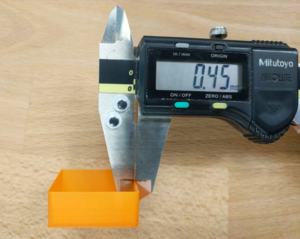Difference between revisions of "FFF Printer Tuning for Accuracy"
Jump to navigation
Jump to search
Poofjunior (talk | contribs) (→Measuring Extrusion Width) |
Poofjunior (talk | contribs) (→Exrusion Width) |
||
| Line 1: | Line 1: | ||
| − | == | + | ==Extrusion Width== |
| + | Even though nozzles come in fixed sizes, the resulting extruded line is almost always slightly thicker after it has been deposited onto the forming part. This happens for a variety of reasons. But the main reason is that each subsequent layer is ''squished'' onto the prior layer with some overlap to ensure that the two layers fuse. Accounting for this thickness is key to getting accurate feature sizes, especially for small holes. | ||
===Measuring Extrusion Width=== | ===Measuring Extrusion Width=== | ||
We can measure extrusion width from a flat surface of a single-layer thick wall. To create such a test object, simply print a cube with an open top in ''vase mode''. From here, measure the wall with a pair of calipers. | We can measure extrusion width from a flat surface of a single-layer thick wall. To create such a test object, simply print a cube with an open top in ''vase mode''. From here, measure the wall with a pair of calipers. | ||
[[File:Extrusion Width Measurement.png|thumb|measuring extrusion width from an object printed in vase mode]] | [[File:Extrusion Width Measurement.png|thumb|measuring extrusion width from an object printed in vase mode]] | ||
Revision as of 14:07, 22 September 2019
Extrusion Width
Even though nozzles come in fixed sizes, the resulting extruded line is almost always slightly thicker after it has been deposited onto the forming part. This happens for a variety of reasons. But the main reason is that each subsequent layer is squished onto the prior layer with some overlap to ensure that the two layers fuse. Accounting for this thickness is key to getting accurate feature sizes, especially for small holes.
Measuring Extrusion Width
We can measure extrusion width from a flat surface of a single-layer thick wall. To create such a test object, simply print a cube with an open top in vase mode. From here, measure the wall with a pair of calipers.
